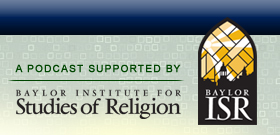

|
Evan Haefeli on the Dutch Origins of Religious Tolerance  Date: March 23rd, 2014
 The story of rise of religious liberty in the United States generally revolves around the influence of English persons and events (e.g., Roger Williams, the Act of Toleration). However, a lesser known piece of the puzzle is the role that the Dutch played in promoting religious toleration back in The Netherlands, as well as their colonial possessions for a significant portion of the 17th century. Dr. Evan Haefeli, an associate professor of history of Columbia University, explains the critical and nuanced role that the good folks from the Low Countries played in shaping the political-religious landscape that emerged in 18th century America. Our conversation begins with Tony’s general ignorance (as usual) of what “The Netherlands” are. Understanding the historical emergence of this disparate territory, and the important role that the long-standing revolt against Spanish Habspurg rule played, is critical to the emergence of religious toleration. Evan notes that The Netherlands are a mixture of different ethnicities and religious groups that are largely unified against a common adversary. It is important to realize that it was not only Protestants, namely Reformed Calvinists and Lutherans, that were revolting from Spanish hegemony, but a number of Catholics were instrumental in Dutch independence. Prof. Haefeli then lays out the interesting tension that characterizes Dutch religious tolerance. Rather than being full bore religious liberty encoded in law, he uses the term “connivance” to describe the de facto system of “looking the other way” when it comes to religious differences. The term “connivance,” while signifying something malevolent in the English language, has a much different connotation in the Low Countries, where it is viewed as “looking through one’s fingers and ignoring some messy details.” The Reformed (Calvinist) Church in Holland and a few other territories of the Low Countries wanted to assert itself as the “public church” that everyone should belong to, but so long as non-Calvinists practied their faith in a non-public and “out of sight” manner, those groups would largely be left alone. Although there was religious tension that did manifest itself in violence at times, Catholics, Jews, and other Protestants were largely left to their own means so long as they were not a nuisance. Evan does note that some of the more aggressive harassment came against Lutherans, who the Calvinists thought should have been Reformed since they were so theologically close. This indicates that religious tension may not always be between two distinct theologies, but rather ones that only have minor differences. We then cross the Atlantic and examine the Dutch foothold in the Americas during the 17th century. To Tony’s surprise, the territory held by the Netherlands was much more vast than what is usually discussed, namely the island of Manhattan; it extened up the Hudson River into the lower portions of New England. However, unlike the English who were primarily interested in settlement, the Dutch were more concerned with trade and, as such, their physical presence was much more sparse and centered around some key trading outposts. The disparate nature of Dutch colonialism (which also included significant portions of modern day Brazil and Africa) led to overextension and their eventual ousting by the English (after a bit of territorial give-and-take). Evan discusses how the notion of a “public church” combined with “connivance” (i.e., looking the other way) that was typical of the homeland was transferred over to the colonies. We also cover a short-lived attempt at radical tolerance in the colonial outpost of New Amstel, which was cut short by the British ousting the Dutch from the territory. We conclude our discussion with a few observations about what this all means for our contemporary notions of religious liberty in the United States. Evan makes the claim that had the Dutch not been ousted from America in the late 1600s, our religious liberty regime might look significantly different with a greater role for a “public church” and with liberty taking on the guise of toleration rather than a solid set of rights. He also discusses some of his general take-aways for our contemporary understanding of religious liberty. Recorded: March 14, 2014. RELATED LINKS Evan Haefeli’s bio at Columbia University’s Department of History. New Netherland and the Dutch Origins of American Religious Liberty, by Evan Haefeli. Captors and Captives: The 1704 French and Indian Raid on Deerfield, by Evan Haefeli. The Political Origins of Religious Liberty, your host’s book that was implicitly mentioned in the podcast. RELATED PODCASTS Tracy McKenzie on the First Thanksgiving. Anthony Gill on the Political Origins of Religious Liberty. Chris Beneke on Religion, Markets, and the Founding Era. Thomas Kidd on the Great Awakening. John Fea on Religion and the American Founding. Russ Roberts and Anthony Gill on Religion and Religious Liberty. Jonathan den Hartog on John Jay. Mark Hall on Roger Sherman, Puritan Patriot. Mark Hall on Religion & the Founding Fathers.
3 Responses to “Evan Haefeli on the Dutch Origins of Religious Tolerance” |
 Search The Podcast
To search the podcast, type a term and click the Search button.
  Browse Podcast Categories
Select a category below to browse the podcast:
   |















[…] Dutch religious tolerance was born. While this principle was not encoded in law, people would “look the other way” so that Calvinists, Catholics, and others could live together peacefully and […]
[…] Evan Haefeli on the Dutch Origins of Religious Liberty. […]
[…] Evan Haefeli on the Dutch Origins of Religious Liberty […]